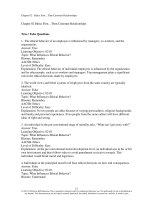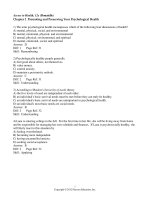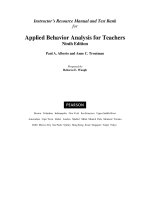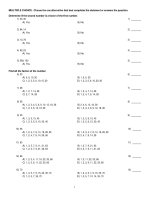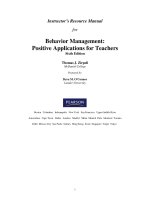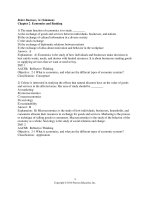Law for business 12th edition barnes test bank
Bạn đang xem bản rút gọn của tài liệu. Xem và tải ngay bản đầy đủ của tài liệu tại đây (302.78 KB, 50 trang )
Chapter 02
Dispute Settlement
True / False Questions
1.
Mediators award decisions based on the merits of a dispute.
True
2.
The U.S. Supreme Court generally disfavors arbitration as a way to settle disputes.
True
3.
False
In international trade disputes, a losing party is not given time to comply with its trade obligations.
True
5.
False
The parties to an arbitration proceeding can select an arbitrator in any way they desire.
True
4.
False
False
International arbitration agreements are enforced through multilateral treaties.
True
False
2-1
Copyright © 2015 McGraw-Hill Education. All rights reserved. No reproduction or distribution without the prior written consent of
McGraw-Hill Education.
6.
Mini trials are also known as summary jury trials.
True
7.
When the issue in a case no longer exists or has become pointless, that issue is considered moot.
True
8.
False
False
Sally files a lawsuit against Jim in a Tennessee court. Jim does not live in Tennessee and has never
been to the state. The Tennessee court may not decide the case unless it can demonstrate that Jim
somehow has a close connection with the state.
True
9.
False
Erik filed a case in a municipal court against Leela for a minor criminal violation. Dissatisfied with
the decision of the court, Erik can now appeal the case in a court of record.
True
False
10. Small claims courts are courts of record.
True
False
11. An individual who is dissatisfied with the decision of a lower court can always take it all the way to
the U.S. Supreme Court.
True
False
12. All opinions of the Supreme Court judges can be cited as precedents.
True
False
2-2
Copyright © 2015 McGraw-Hill Education. All rights reserved. No reproduction or distribution without the prior written consent of
McGraw-Hill Education.
13. The adversary system in the United States is based on the idea that the truth will emerge in
courtrooms through a "battle of words" between two lawyers.
True
False
14. In a civil case, the plaintiff need not have the preponderance of the evidence on his or her side.
True
False
15. A new trial is required for cases remanded by an appellate court.
True
False
Multiple Choice Questions
16. Under the Uniform Arbitration Act, a court:
A. cannot hold that the dispute was not arbitrable under the agreement of the parties.
B. will not review the wisdom of the decision of an arbitrator.
C. cannot hold that the arbitrator exceeded his or her authority.
D. can publish its arbitration awards.
2-3
Copyright © 2015 McGraw-Hill Education. All rights reserved. No reproduction or distribution without the prior written consent of
McGraw-Hill Education.
17. Which of the following statements is true about a minitrial?
A. A minitrial involves a six-member mock jury empaneled by the court that hears a shortened
presentation of the case by the lawyers for each side and renders an advisory verdict.
B. A minitrial often involves a neutral third-party advisor who will render a nonbinding opinion, if a
settlement is not reached, regarding how a dispute is likely to be resolved if it goes to trial.
C. A minitrial is conducted under court guidance.
D. A minitrial differs from mediation in that the third-party to whom the dispute is submitted
decides the outcome.
18. In the private judging method of dispute resolution, _____.
A. a hired judge renders a binding opinion after hearing the evidence and arguments of the
parties
B. executives of the disputing companies, who have settlement authority, hear a shortened
presentation of the case by the lawyers for each side
C. a six-member mock jury empaneled by the court hears a shortened presentation of the case by
the lawyers for each side
D. executives of the disputing companies meet with lawyers for each side to negotiate a settlement
19. An individual appointed within an organization to settle disputes is called a(n) _____.
A. private judge
B. arbitrator
C. mediator
D. ombudsperson
2-4
Copyright © 2015 McGraw-Hill Education. All rights reserved. No reproduction or distribution without the prior written consent of
McGraw-Hill Education.
20. Jurisdiction is defined as:
A. the authority of a court to hear and determine disputes.
B. the unlimited authority of the court.
C. the process by which legal cases are decided.
D. the power an individual appointed within an organization possesses to settle disputes.
21. Adia filed a case against Chang in the court at Ohio. However, Chang had never visited Ohio and
had no personal ties with anyone in Ohio. Chang could successfully argue that the court:
A. lacked personal jurisdiction.
B. was in proximity to the place where Chang resides.
C. was limited by subject matter jurisdiction.
D. did not have judges that would understand the language spoken by him.
22. Municipal courts:
A. are courts of record.
B. are known as superior courts.
C. are known as justice of the peace courts in rural areas.
D. are courts that handle civil disputes involving large amounts of money.
23. Trial courts differ from inferior courts in that the trial courts:
A. are courts of limited jurisdiction.
B. are limited by the amount of civil damages that can be awarded.
C. are courts of record, and their decisions can be appealed.
D. are called municipal courts in urban areas.
2-5
Copyright © 2015 McGraw-Hill Education. All rights reserved. No reproduction or distribution without the prior written consent of
McGraw-Hill Education.
24. Generally, the role of appellate courts is to:
A. hear witnesses once again.
B. establish new facts for all cases.
C. accept the findings of the trial court with minor changes even if it goes against all the evidence.
D. review the proceedings in the trial court and correct legal errors made by the trial judge.
25. A certain court receives an appeal by parties dissatisfied with the decision of a trial court. However,
neither does it hear any witnesses nor does it review new facts about the case. The court discussed
in the example is a(n) _____.
A. municipal court
B. inferior court
C. appellate court
D. justice of peace court
26. Karl, a resident of Ohio, was convicted of a bank robbery worth $90,000 in California. In which of
the following courts should his case be filed?
A. Small claims court
B. Tax court
C. District court
D. Justice of peace court
2-6
Copyright © 2015 McGraw-Hill Education. All rights reserved. No reproduction or distribution without the prior written consent of
McGraw-Hill Education.
27. District courts:
A. only review the legal conclusions reached by lower federal courts.
B. are the intermediate courts of the federal court system.
C. have both fact-finding and law-finding functions.
D. are specialized courts in the federal court system.
28. A U.S. court of appeals is empowered to:
A. take up appeals only from other districts.
B. review legal conclusions reached by lower federal courts.
C. hear cases that have been appealed from Supreme Court decisions.
D. take the final responsibility for interpretation of the Constitution and federal statutes.
29. The primary way a case can be appealed to the Supreme Court is through a _____.
A. writ of habeas corpus
B. writ of quo warranto
C. writ of certiorari
D. writ of mandamus
30. Writ of certiorari (cert.) may be granted when:
A. a person does not want to appeal to the Supreme Court.
B. there have been conflicting decisions in similar cases by different courts of appeal.
C. the Supreme Court has too many cases to be heard and has no time to take up a new case.
D. a case has the validity of a federal statute in agreement.
2-7
Copyright © 2015 McGraw-Hill Education. All rights reserved. No reproduction or distribution without the prior written consent of
McGraw-Hill Education.
31. Which of the following statements about the adversary system is true?
A. The adversary system represents the idea that truth is best discovered through the presentation
of competing ideas.
B. The judge, in an adversary system, is actively involved in determining the facts of a case.
C. The lawyers, in an adversary system, do not persuade the judge that the other party's view of
the facts is in error.
D. The judges have a duty to direct the search for truth rather than expecting it to emerge from
the efforts of the lawyers for the parties.
32. Which of the following is a criticism of the adversary system?
A. Honest witnesses can be confused by hostile questioning.
B. The system concentrates on the competition to win, which discourages overstatement of the
truth.
C. The judge's role, in the adversary system, is active.
D. The system does not work when the opposing lawyers are of unequal skill, giving an advantage
to the poor and the needy.
2-8
Copyright © 2015 McGraw-Hill Education. All rights reserved. No reproduction or distribution without the prior written consent of
McGraw-Hill Education.
33. The Smiths, an affluent family, own a hospitality chain called Smith Hotels Inc. When a lawsuit was
filed against the hotel for serving stale food to its guests, the managers of the hotel decided to
hire a lawyer who practices in an adversary system. How is this situation advantageous to Smith
Hotels Inc.?
A. The system makes it easier for a biased judge to control the outcome of a case.
B. The wealthy can hire better lawyers as the system does not work when the opposing lawyers are
of unequal skill.
C. The system lays emphasis on the competition to win which discourages overstatement of the
truth.
D. The adversary system resents the idea that truth is best discovered through the presentation of
competing ideas.
34. Which of the following statements is true of pleadings?
A. The first step in starting a lawsuit is the serving of a summons on the defendant.
B. These are the first documents filed with the court, and they start and define the lawsuit.
C. The case is set for trial on the court calendar once the pleadings have commenced.
D. Both disputed and undisputed matters in the pleadings are tried in court.
35. In the context of filing a lawsuit, a complaint:
A. must contain sufficient facts to show that the plaintiff is entitled to some legal relief.
B. is a rule of law enabling the defendant to win even if all of the plaintiff's allegations are true.
C. was created to help deal with the increasing congestion of cases in most civil courts.
D. is a procedural device that is designed to narrow down issues to be proved at trial.
2-9
Copyright © 2015 McGraw-Hill Education. All rights reserved. No reproduction or distribution without the prior written consent of
McGraw-Hill Education.
36. A rule of law enabling a defendant to win even if all of plaintiff's allegations are true is a(n) _____.
A. counterclaim
B. affirmative defense
C. deposition
D. judgment notwithstanding the verdict
37. A new claim stating that plaintiff owes defendant damages because of harm resulting from the
incident alleged in the complaint is called a(n) _____.
A. counterclaim
B. affirmative defense
C. cross-claim
D. dissenting opinion
38. A motion to dismiss made by a defendant is granted when:
A. the defendant is scared of losing the case.
B. it is clear that the plaintiff does not have a case, and it would be wasteful to continue.
C. either party feels that the judge is not impartial.
D. people or groups other than the parties involved are interested in the outcome of a certain
appeal.
2-10
Copyright © 2015 McGraw-Hill Education. All rights reserved. No reproduction or distribution without the prior written consent of
McGraw-Hill Education.
39. Salim files a case against Nina for nonpayment of dues. Before the trial, Nina is examined under
oath in the presence of Salim's attorney. This process of examination is known as a(n) _____.
A. deposition
B. interrogatory
C. pretrial conference
D. default judgment
40. A procedural device that is designed to narrow issues to be proved at trial or to facilitate a
settlement is the _____.
A. alternative dispute resolution
B. mediation agreement
C. judgment notwithstanding the verdict
D. pretrial conference
41. Which of the following statements is true of the presentation of testimony?
A. Under direct examination, each witness is sworn and then examined by the defendant's
attorney.
B. A defendant's attorney may cross-examine each witness, trying to raise doubts as to the
person's credibility or trustworthiness.
C. A defendant's attorney may conduct a redirect examination to clarify the plaintiff's view of the
facts.
D. During a witness's testimony, the opposing attorney cannot object to the presentation of certain
evidence.
2-11
Copyright © 2015 McGraw-Hill Education. All rights reserved. No reproduction or distribution without the prior written consent of
McGraw-Hill Education.
42. A _____ is designed to reach things belonging to the debtor that are in the hands of third parties.
A. writ of quo warranto
B. writ of garnishment
C. writ of certiorari
D. writ of mandamus
43. Which of the following is true of the burden of proof in a criminal trial?
A. It should be "beyond a reasonable doubt."
B. It is placed on the defendant.
C. During the closing of a case, when the defendant's attorney goes first, he or she has the burden
of proof.
D. It is similar to that for civil cases.
44. The term amicus curiae means:
A. friendly cure or the amicable resolution to a mediated dispute.
B. friend of the court and refers to briefs filed by third parties interested in the outcome of a
certain appeal.
C. small couriers or the briefs, originally used by foot messengers, which are used to communicate
between lawyers and the courts.
D. the name for the conductor of an arbitration, a position originally filled by medieval clergy.
2-12
Copyright © 2015 McGraw-Hill Education. All rights reserved. No reproduction or distribution without the prior written consent of
McGraw-Hill Education.
45. In order to appeal a decision, _____.
A. a party must claim that the court made an error of law or that the evidence in the trial did not
support the trial court's decision.
B. a party need not have objected to a judge's action at the time the alleged error was made.
C. a party must prepare for a new fact-finding process and must be dissatisfied with the judgment
of the court.
D. the defendant must show that the errors made were not material.
46. A record in writing of the entire trial proceedings including the testimony of all the witnesses and
any discussions between the judge and the attorneys that must be prepared and forwarded to the
appeals court is called a _____.
A. treatise
B. citation
C. transcript
D. brief
Short Answer Questions
2-13
Copyright © 2015 McGraw-Hill Education. All rights reserved. No reproduction or distribution without the prior written consent of
McGraw-Hill Education.
47. The employees of Claudio Inc. were on strike for 30 days and that led to huge losses for the
business. Owing to loss of business and wages, both parties wanted to settle the dispute but were
unable to negotiate successfully. Which method of dispute settlement is best suited to them?
Why?
48. Explain the differences between trial courts and inferior courts.
49. The function of a judge in the United States differs from that in Europe. Explain.
2-14
Copyright © 2015 McGraw-Hill Education. All rights reserved. No reproduction or distribution without the prior written consent of
McGraw-Hill Education.
50. Under what conditions can one or more members of a class may sue or be sued as representative
of a class? What type of lawsuit can their claims be consolidated into?
51. Explain the concept of a motion to dismiss.
2-15
Copyright © 2015 McGraw-Hill Education. All rights reserved. No reproduction or distribution without the prior written consent of
McGraw-Hill Education.
Chapter 02 Dispute Settlement Answer Key
True / False Questions
1.
Mediators award decisions based on the merits of a dispute.
(p. 27)
FALSE
AACSB: Analytic
Blooms: Understand
Difficulty: 2 Medium
Learning Objective: 02-01 Describe the various ways to settle disputes.
Topic: Means of Dispute Settlement
2.
The U.S. Supreme Court generally disfavors arbitration as a way to settle disputes.
(p. 28)
FALSE
AACSB: Analytic
Blooms: Remember
Difficulty: 1 Easy
Learning Objective: 02-01 Describe the various ways to settle disputes.
Topic: Means of Dispute Settlement
3.
The parties to an arbitration proceeding can select an arbitrator in any way they desire.
(p. 28)
TRUE
AACSB: Analytic
Blooms: Remember
Difficulty: 1 Easy
Learning Objective: 02-01 Describe the various ways to settle disputes.
2-16
Copyright © 2015 McGraw-Hill Education. All rights reserved. No reproduction or distribution without the prior written consent of
McGraw-Hill Education.
Topic: Means of Dispute Settlement
4.
In international trade disputes, a losing party is not given time to comply with its trade
(p. 29)
obligations.
FALSE
AACSB: Analytic
Blooms: Remember
Difficulty: 1 Easy
Learning Objective: 02-01 Describe the various ways to settle disputes.
Topic: Means of Dispute Settlement
5.
International arbitration agreements are enforced through multilateral treaties.
(p. 29)
TRUE
AACSB: Analytic
Blooms: Remember
Difficulty: 1 Easy
Learning Objective: 02-01 Describe the various ways to settle disputes.
Topic: Means of Dispute Settlement
6.
Mini trials are also known as summary jury trials.
(p. 29)
FALSE
AACSB: Analytic
Blooms: Understand
Difficulty: 2 Medium
Learning Objective: 02-01 Describe the various ways to settle disputes.
Topic: Means of Dispute Settlement
2-17
Copyright © 2015 McGraw-Hill Education. All rights reserved. No reproduction or distribution without the prior written consent of
McGraw-Hill Education.
7.
When the issue in a case no longer exists or has become pointless, that issue is considered
(p. 30- moot.
31)
TRUE
AACSB: Analytic
Blooms: Understand
Difficulty: 2 Medium
Learning Objective: 02-01 Describe the various ways to settle disputes.
Topic: Means of Dispute Settlement
8.
Sally files a lawsuit against Jim in a Tennessee court. Jim does not live in Tennessee and has
(p. 31)
never been to the state. The Tennessee court may not decide the case unless it can
demonstrate that Jim somehow has a close connection with the state.
TRUE
AACSB: Reflective Thinking
Blooms: Apply
Difficulty: 3 Hard
Learning Objective: 02-02 Define jurisdiction and explain the jurisdictional limits of small claims; trial; and appellate courts.
Topic: Means of Dispute Settlement
9.
Erik filed a case in a municipal court against Leela for a minor criminal violation. Dissatisfied with
(p. 33)
the decision of the court, Erik can now appeal the case in a court of record.
FALSE
AACSB: Reflective Thinking
Blooms: Apply
Difficulty: 3 Hard
Learning Objective: 02-02 Define jurisdiction and explain the jurisdictional limits of small claims; trial; and appellate courts.
Topic: State Courts
2-18
Copyright © 2015 McGraw-Hill Education. All rights reserved. No reproduction or distribution without the prior written consent of
McGraw-Hill Education.
10.
Small claims courts are courts of record.
(p. 33)
FALSE
AACSB: Analytic
Blooms: Remember
Difficulty: 1 Easy
Learning Objective: 02-02 Define jurisdiction and explain the jurisdictional limits of small claims; trial; and appellate courts.
Topic: State Courts
11.
An individual who is dissatisfied with the decision of a lower court can always take it all the way
(p. 36)
to the U.S. Supreme Court.
FALSE
AACSB: Analytic
Blooms: Remember
Difficulty: 1 Easy
Learning Objective: 02-03 Explain why all cases can't be appealed all the way to the Supreme Court.
Topic: Federal Courts
12.
All opinions of the Supreme Court judges can be cited as precedents.
(p. 36)
FALSE
AACSB: Analytic
Blooms: Understand
Difficulty: 2 Medium
Learning Objective: 02-03 Explain why all cases can't be appealed all the way to the Supreme Court.
Topic: Federal Courts
2-19
Copyright © 2015 McGraw-Hill Education. All rights reserved. No reproduction or distribution without the prior written consent of
McGraw-Hill Education.
13.
The adversary system in the United States is based on the idea that the truth will emerge in
(p. 36)
courtrooms through a "battle of words" between two lawyers.
TRUE
AACSB: Analytic
Blooms: Remember
Difficulty: 1 Easy
Learning Objective: 02-03 Explain why all cases can't be appealed all the way to the Supreme Court.
Topic: The Adversary System
14.
In a civil case, the plaintiff need not have the preponderance of the evidence on his or her side.
(p. 45)
FALSE
AACSB: Analytic
Blooms: Remember
Difficulty: 1 Easy
Learning Objective: 02-05 Identify the different stages of a lawsuit.
Topic: Procedure
15.
A new trial is required for cases remanded by an appellate court.
(p. 47)
TRUE
AACSB: Analytic
Blooms: Understand
Difficulty: 2 Medium
Learning Objective: 02-06 Discuss how an appeal works and why most appeals fail.
Topic: Appellate Procedure
Multiple Choice Questions
2-20
Copyright © 2015 McGraw-Hill Education. All rights reserved. No reproduction or distribution without the prior written consent of
McGraw-Hill Education.
16.
Under the Uniform Arbitration Act, a court:
(p. 28)
A. cannot hold that the dispute was not arbitrable under the agreement of the parties.
B. will not review the wisdom of the decision of an arbitrator.
C. cannot hold that the arbitrator exceeded his or her authority.
D. can publish its arbitration awards.
Most states have passed the Uniform Arbitration Act, which makes both the agreement of
parties to arbitrate and the arbitration award enforceable in court. A court will not review the
wisdom of the decision of an arbitrator. It may, however, hold that the dispute was not
arbitrable under the agreement of the parties, or that the arbitrator exceeded his or her
authority, or acted arbitrarily, capriciously, or in a discriminatory manner.
AACSB: Analytic
Blooms: Remember
Difficulty: 1 Easy
Learning Objective: 02-01 Describe the various ways to settle disputes.
Topic: Means of Dispute Settlement
2-21
Copyright © 2015 McGraw-Hill Education. All rights reserved. No reproduction or distribution without the prior written consent of
McGraw-Hill Education.
17.
Which of the following statements is true about a minitrial?
(p. 29)
A. A minitrial involves a six-member mock jury empaneled by the court that hears a shortened
presentation of the case by the lawyers for each side and renders an advisory verdict.
B. A minitrial often involves a neutral third-party advisor who will render a nonbinding opinion,
if a settlement is not reached, regarding how a dispute is likely to be resolved if it goes to
trial.
C. A minitrial is conducted under court guidance.
D. A minitrial differs from mediation in that the third-party to whom the dispute is submitted
decides the outcome.
The minitrial often involves a neutral third-party advisor. If a settlement is not reached, she or
he will render a nonbinding opinion regarding how the dispute is likely to be resolved if it goes
to trial, and how the court is likely to rule on factual and evidentiary issues.
AACSB: Analytic
Blooms: Understand
Difficulty: 2 Medium
Learning Objective: 02-01 Describe the various ways to settle disputes.
Topic: Means of Dispute Settlement
2-22
Copyright © 2015 McGraw-Hill Education. All rights reserved. No reproduction or distribution without the prior written consent of
McGraw-Hill Education.
18.
In the private judging method of dispute resolution, _____.
(p. 30)
A. a hired judge renders a binding opinion after hearing the evidence and arguments of the
parties
B. executives of the disputing companies, who have settlement authority, hear a shortened
presentation of the case by the lawyers for each side
C. a six-member mock jury empaneled by the court hears a shortened presentation of the case
by the lawyers for each side
D. executives of the disputing companies meet with lawyers for each side to negotiate a
settlement
In the private judging, or "rent-a-judge," method of dispute resolution, a hired judge (who is
often a retired judge) renders a binding opinion after hearing the proofs and arguments of the
parties.
AACSB: Analytic
Blooms: Remember
Difficulty: 1 Easy
Learning Objective: 02-01 Describe the various ways to settle disputes.
Topic: Means of Dispute Settlement
19.
An individual appointed within an organization to settle disputes is called a(n) _____.
(p. 30)
A. private judge
B. arbitrator
C. mediator
D. ombudsperson
An ombudsperson is an individual appointed within an organization to settle disputes.
AACSB: Analytic
2-23
Copyright © 2015 McGraw-Hill Education. All rights reserved. No reproduction or distribution without the prior written consent of
McGraw-Hill Education.
Blooms: Remember
Difficulty: 1 Easy
Learning Objective: 02-01 Describe the various ways to settle disputes.
Topic: Means of Dispute Settlement
20.
Jurisdiction is defined as:
(p. 31)
A. the authority of a court to hear and determine disputes.
B. the unlimited authority of the court.
C. the process by which legal cases are decided.
D. the power an individual appointed within an organization possesses to settle disputes.
Jurisdiction is the authority of a court to hear and determine disputes.
AACSB: Analytic
Blooms: Understand
Difficulty: 2 Medium
Learning Objective: 02-02 Define jurisdiction and explain the jurisdictional limits of small claims; trial; and appellate courts.
Topic: Means of Dispute Settlement
2-24
Copyright © 2015 McGraw-Hill Education. All rights reserved. No reproduction or distribution without the prior written consent of
McGraw-Hill Education.
21.
Adia filed a case against Chang in the court at Ohio. However, Chang had never visited Ohio
(p. 31)
and had no personal ties with anyone in Ohio. Chang could successfully argue that the court:
A. lacked personal jurisdiction.
B. was in proximity to the place where Chang resides.
C. was limited by subject matter jurisdiction.
D. did not have judges that would understand the language spoken by him.
In this scenario, Chang can successfully argue that the court lacks personal jurisdiction. A court
may not decide a legal dispute unless it has personal jurisdiction over the defendant. Personal
jurisdiction generally does not exist unless the defendant has some close connection with the
territory where the suit is brought. Personal jurisdiction is likely to exist if the defendant is a
resident of the territory where the court is located or if a nonresident defendant is physically
present in that territory.
AACSB: Reflective Thinking
Blooms: Apply
Difficulty: 3 Hard
Learning Objective: 02-02 Define jurisdiction and explain the jurisdictional limits of small claims; trial; and appellate courts.
Topic: Means of Dispute Settlement
2-25
Copyright © 2015 McGraw-Hill Education. All rights reserved. No reproduction or distribution without the prior written consent of
McGraw-Hill Education.
